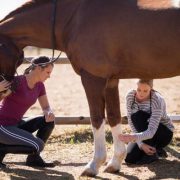Welfare considerations for management of horses on prolonged periods of box rest
Welfare considerations for management of horses on prolonged periods of box rest

our summary:
Pearson, G. (2024) Welfare considerations for management of horses on prolonged periods of box rest. Equine Veterinary Education, 36 (7), pp. 342-346.
The aim of this clinical commentary was to highlight the welfare implications of confinement in horses and to consider options for successful management of horses undergoing prolonged box rest.
The author begins by discussing the concept of welfare where the aim is not just to meet the Five Freedoms (a life worth living), but rather to provide positive experiences (a good life) using the Five Domains model. Welfare represents how an individual horse feels which is dependent on the balance between the negative and positive experiences, with behavioural signs observed as indicators of the horse’s mental state and stress level. However horses may use a variety of coping mechanisms which can make it hard to evaluate stress levels.
Any box rest management plan should be a combination of interventions that are tailored to the individual horse-owner combination, as interventions that the owner will find easy are more likely to be implemented. The author suggests the COM-B model: Capability (does the owner have the psychological and physical capability?); Opportunity (are the interventions feasible for the owner?); Motivation (does the intervention fit in with owner’s habit and normal routine?) is useful when devising a plan that will lead to a change in owner behaviour.
The aim of a box rest management plan is to restore the horse to full physical health with minimum impact on their mental health, as well as keeping both horse and owner safe during the period of confinement. The author suggests a number of areas to consider including in any plan.
- Companionship: provide opportunities for the horse to engage in physical contact.
- Training: provide mental stimulation by getting the horse to learn new tasks or perform trained ones.
- Further environment enrichment: to stimulate and maximise the horse’s senses.
- Psychopharmaceuticals: if used appropriately can have a positive impact on the horse’s mood and help them cope with the stress associated with confinement. It is important for veterinary practitioners to consider whether the drug is improving the horse’s welfare or if it is only making the horse appear calmer externally and the length of confinement as some drugs can take several weeks for the beneficial effects to be seen.
- Re-introduction of exercise: the timing and how much exercise will be dependent on the individual circumstances of the case and should bear in mind the safety of both the horse and owner.
This clinical commentary emphasises the importance of an individualised management plan for any horse that will be confined for a significant period of box rest. Any plan should be mutually agreed with the owner to help ensure compliance as their motivation to change their behaviour regarding their horse’s care will increase the likelihood of the success of the management plan.
The following may also be of interest:
inFOCUS: Quality of Life assessment tools [RCVS Knowledge] [online] Available from: https://infocus.rcvsknowledge.org/qol-spotlight-on-quality-of-life-assessment-tools/ [Accessed 24 June 2024]
Taylor, C. and Dubuc, J. (2023) Box rest and analgesia compared to arthroscopic debridement for lame horses with hindlimb subchondral lucencies. Veterinary Evidence, 8 (2). https://doi.org/10.18849/ve.v8i2.603
Claiming CPD for reading inFOCUS articles
Reading and reflecting on articles can count towards your CPD, and we have a template to help you with the process.
Image copyright attribute: welcomia








Leave a Reply
Want to join the discussion?Feel free to contribute!